A quick quiz.
a) How would you describe this boy’s expression? Not a trick question, just the first word that pops into your head.
b) And his?
c) His?
d) And finally, his?
If any of your answers were along the lines of “smiling”, “grinning”, “laughing”, “smirking” or similar then, like me, you have some very serious questions to ask of the BBC’s news service.
Because according to the BBC the above individuals are, respectively:
a) The teenage victim of an incendiary bomb attack on an Aleppo school, arriving at a field hospital shortly after having been exposed to a “napalm-type substance”.
b) One of the medics who attended to the “dozens” of burned and dying child and teenage victims of the attack being interviewed the very next day.
c) An alleged eye witness to the attack being interviewed less than a week later.
d) One of the teachers from the school that was allegedly attacked being treated for napalm or thermite burns.
Napalm… or no-palm?
The teenager in the black vest appears fleetingly at 2 minutes 8 seconds in Ian Pannell and Darren Conway’s 29 August 2013 report Syria crisis: Incendiary bomb victims ‘like the walking dead’ – broadcast on the BBC Ten O’Clock News just as parliament was voting on whether to intervene militarily in Syria. [1]
The admittedly fuzzy image of the boy at the head of this piece has been enlarged and adjusted for colour, brightness, contrast and sharpness from this screencap from the sequence. [2]
At 31:56 in the BBC Panorama special Saving Syria’s Children, screened a month later on 30 September 2013, the same boy is seen moments after the above frame, apparently hobbling towards the hospital clutching his torn jeans. At 35:15 he appears again, exclaiming “cover me” while allegedly being treated for his injuries by Dr Saleyha Ahsan.
Three of the alleged victims who arrive with the boy also appear in this sequence filmed inside the hospital. Watch it through a couple of times then take a look at the observations made here.
In the course of complaints correspondence the BBC has conceded that the “boy in the white shirt, second from the right appears relatively unscathed” while claiming that the adolescent in red, Anas Said Ali, “died a few days later in hospital in Turkey”. [3] BBC Complaints has also provided an image of Mohammed Asi – the central figure who makes the pronounced hand gesture – which purports to show him “two weeks after the attack in hospital in Turkey”.
Note too this sequence from Pannell and Conway’s August 2013 report in which alleged victim Ahmed Darwish, his body smeared with white burns cream, appears to nod to someone off-screen prior to turning to address the camera:
Two points:
- All of this footage was shot by Darren Conway, Saving Syria’s Children’s cameraman, director and producer. Conway was reporter Ian Pannell’s sole BBC colleague on the Panorama assignment. There is no question of any part of the footage being third party material. Its veracity is therefore integral to the credibility of this BBC report and ultimately to that of the BBC’s news service. [4]
- Dr Saleyha Ahsan, a former British army captain and one of the two British doctors who features in the report, has a personal connection with an army officer who runs large-scale, highly sophisticated medical simulation exercises in which “actors and make-up artists mimic even the most severe of injuries“. (Update: see also this this segment of a recent presentation for Frome Stop War)
Questions about the image of the apparently grinning teenager have been raised in formal complaints to the BBC Trust on two separate occasions. [5]
Napalm… or facepalm?
This moustachioed medic pops up at various points in the BBC’s footage from the day of the attack, bustling around Atareb Hospital to no very clear purpose, occasionally rubbing shoulders with Dr Rola Hallam.
- The medic at Atareb Hospital gate with Dr Rola Hallam in the foreground in Ian Pannell and Darren Conway’s 29 August 2013 BBC News report
- The medic in shot with Dr Hallam once more in Panorama: Saving Syria’s Children
During the seven minute interview which he provides to the Aleppo News Network the next day [6] (still wearing the same blue V-neck tunic) he appears to succumb to more than one bout of levity (from 12:58 to 13.00 and, more markedly, from 17:22 to 17:29 – see sequence below). This seems – to put it mildly – highly incongruous in someone who had supposedly spent the previous day tending to, according to Dr Ahsan, “up to 40 severely burned people with up to 70 to 80 percent burns, second to third degree”. [7]
Nay, nay and thrice nay(palm)?
Alleged eye witness to the attack Abu Youssef, interviewed in a video uploaded to You Tube less than a week after the alleged attack, also sets sail for remote shores of counterintuitivity in his jarring response to the supposedly horrific events of Monday 26 August 2013. An Italian subtitled version of the same interview translates Youssef’s words at this point as “The first bomb hit a residential area, the second one a student centre”.
As with the chuckling medic’s interview above this material was not filmed by the BBC’s Darren Conway. However, it was referenced by BBC Complaints Director Colin Tregear in a letter of 23 April 2014 (see first link at footnote 13, page 5), who uses the video in which Youssef appears to support his claim that “Other material which is available on the internet also appears to suggest that the burns and injuries sustained by the victims were genuine.”
In an earlier segment of the interview Youssef estimates the time of the incendiary attack at between 5.30 and 6.00pm, “more or less” – representing the outlier in the six-hour span on offer, which starts with Human Rights Watch’s assessment of “around midday”, continues with the Violations Documentation Center in Syria’s “02:00 pm” and proceeds to Ian Pannell’s categoric “around 5.30pm at the end of the school day”. That Pannell’s BBC partner Darren Conway, when presented with the full range of options, still seemed undecided adds further fuel to the conflagration of uncertainty around what one might reasonably imagine to be the most basic – and readily verifiable – fact of the entire supposed incident.
(Na)palmed off with amateurs?
The putative school teacher appears in other non-BBC footage posted on YouTube and subsequently screened in Sky News and ITN reports of the alleged attack.
Initially bridling at the approach of the unidentified cameraman, this rather unlikely pedagogue nevertheless goes on to relate, somewhat woodenly, the events he has supposedly just witnessed:
We have an institute where we teach students. The plane hit a residential area in Urum al-Kubra. We tried to get out quickly so we didn’t get hurt but it seems someone’s fate caught up with them today. A gathering of students formed which is normal as the students needed to leave under these circumstances and the plane hit us. [8] [9]
The “teacher” – identifiable by the triangle of three distinct black marks on his t-shirt – also appears from 33:38 in Saving Syria’s Children, lurching and swaying in what appears an exaggerated manner behind BBC reporter Ian Pannell.

The “teacher” swaying and lurching in exaggerated manner in BBC’s ‘Saving Syria’s Children’
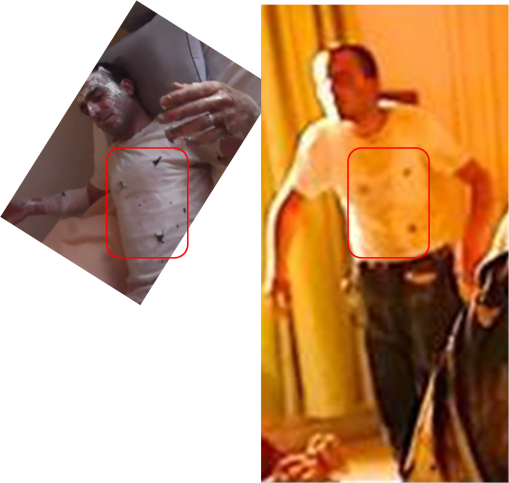
The three prominent black marks identify the “teacher” featured in an interview posted on You Tube and shown on Sky and ITN as the weirdly swaying figure in Panorama.
Among some of the other strange performances recorded at Atareb Hospital on 26 August 2013 is this curiously impassive young woman who briefly appears in this You Tube video, the desultory daubs of burns cream on her face presumably indicating that she is to be understood as a victim of the supposed Urm al-Kubra incendiary bomb attack. (The other young woman in the video, who offers a contrastingly vitriolic performance, seemingly lost the use of her legs when filmed by a BBC camera upon her arrival at Atareb Hospital – in an ISIS ambulance – earlier in the day).
Noteworthy too are the strikingly chipper – not to say sinister – Instagram postings of Saving Syria’s Children’s “Fixer/Translator” Mughira Al Sharif around the time of the alleged attack:

Image dated 26 August 2013, the day of the alleged incendiary bomb attack featured in ‘Saving Syria’s Children’. Mughira Al Sharif was present at Atareb Hospital as the alleged victims arrived.

Image dated 27 August 2013, the day after Sharif had allegedly witnessed the aftermath of a “mass casualty event” in which dozens of people, including children and teenagers, had supposedly been killed or injured.
The first of Sharif’s Instagram images above, captioned “Somewhere in #syria with some friends”, may not actually have been taken on 26 August 2013. Evidently, however, Sharif found a leisurely moment to upload it to the site on that day, during the morning of which he was chauffeuring Ian Pannell through an ISIS checkpoint on the way to visit a frontline clinic [10] and some time later presumably served in the same capacity as Pannell, Conway and Doctors Hallam and Ahsan journeyed on to Atareb Hospital where they opportunely recorded the dramatic alleged aftermath of the Urm al-Kubra incendiary attack for global BBC audiences.
Clearly Sharif was not so traumatised at witnessing “dozens” of allegedly injured and dying children and teenagers at Atarab that he felt any qualms about posting the second image above – one of several on his Instagram account jocularly celebrating the involvement of children in the Syrian conflict, with captions such as “The youngest revolutionary!” – the very next day. [11]
- Mughira Al Sharif at the wheel as Ian Pannell’s team proceeds towards an ISIS checkpoint on the morning of Monday 26 August 2013 (10:33 in Saving Syria’s Children http://bit.ly/1wO3p2w)
- Later the same day a figure closely resembling Al Sharif looks on impassively as Dr Saleyha Ahsan tends to an alleged victim of the Urm al-Kubra incendiary attack at Atareb Hospital.
War photography… or war fiction?
Scepticism over the BBC’s account of the Urm al-Kubra incendiary attack has been widespread since the material was broadcast over two years ago. Scrutiny has been brought to bear by, among others, former UK ambassador Craig Murray and (resulting in a brouhaha with Ofcom) Russian broadcaster RT.
Middle East specialist Dr. Christopher M. Davidson recently observed:
https://twitter.com/dr_davidson/status/662594313122115584
The reference is to the point made in this interview (discussed at greater length here) that BBC Worldwide has been diligently and selectively blocking all copies of Saving Syria’s Children posted to You Tube, ostensibly on copyright grounds (albeit numerous other editions of Panorama remain freely available). [12]
Perhaps this Wikipedia entry offers some historical context within which the enigma of Saving Syria’s Children, and the rationale of its authors, may be considered:
During the American Civil War (1861–65), Haley Sims and Alexander Gardner began recreating scenes of battle in order to overcome the limitations of early photography with regard to the recording of moving objects. Their reconfigured scenes were designed to intensify the visual and emotional effects of battle.[18] Gardner and Mathew Brady rearranged bodies of dead soldiers during the Civil War in order to create a clear picture of the atrocities associated with battle.[19] In Soldiers on the Battlefield (1862) Brady produced a controversial tableau of the dead within a desolate landscape. This work, along with Alexander Gardner’s 1863 work Home of a Rebel Sharpshooter[20] were images which, when shown to the public, brought home the horrific reality of war.[21]
Notes
[1] As the website OffGuardian notes:
As it happens the motion for intervention was unexpectedly defeated by a narrow majority. If this had not happened the BBC’s footage would unquestionably have served as very timely and useful PR in support of the coming war against Assad.
[2] The screencap was made from the BBC iPlayer copy of a Newsnight retrospective on the parliamentary vote broadcast exactly a year later and submitted as part of a separate but related complaint (which met with mixed but interesting results). The quality of the image, while relatively poor, is nonetheless much better than the results of attempting to capture the same moment from the contemporary BBC News report.
[3] In a Human Right Watch report (p15), Dr Ahsan claims Anas Said Ali died “two weeks later”. The Violations Documentation Center in Syria lists “Anas al-Sayed Ali” and other alleged victims whom the BBC claims died at later dates as having been killed on 26 August 2013, the day of the alleged attack.
[4] Conway was awarded an OBE six months after the broadcast of Saving Syria’s Children.
[5] In an email to the BBC Trust of 5 November 2014 I wrote:
I wish to draw one final matter to the attention of the Trustees before their meeting tomorrow.
In this image (also below and attached) from the BBC One Ten O’Clock News of 29 August 2013, the boy in the black vest at the right of the picture is looking into the camera and grinning broadly. I think any reasonable person can see this plainly.
What possible reason would someone who has just been sprayed with a “napalm-like substance” have for amusement? As noted in my first letter to the BBC on this matter, Kim Phuc, the napalm bombing survivor known from a famous Vietnam War photograph has said “napalm is the most terrible pain you can imagine”.
In its final decision on my complaint about Saving Syria’s Children the BBC Trust cursorily noted the point before going on to state of “a number of additional matters” which I had raised:
…the Committee decided that it would not be appropriate, proportionate or cost effective to conduct an investigation into these additional matters.
Another complainant who had expressly requested that the relevant frames from the original footage be presented to Trustees for their consideration received even shorter shrift, with the Trust merely noting that “ten new allegations” which had not been submitted at earlier stages of the complaint “did not persuade Trustees to change their initial conclusion that Panorama and associated BBC content had depicted events broadly as they occurred.” (A summary of the complainant’s “ten new allegations” is here).
[6] According to a private translation of the reporter/presenter’s words from the start of the Aleppo News Network video.
[7] An Arabic speaking correspondent has further observed of the medic’s interview:
The so called MD with his neat and clean overhaul [sic] said that they were listening through a walky talky to the pilot conversation with the command center (ask any army veteran to tell you how impossible this was).
The other interviewee featured in the Aleppo News Network video – resplendent, incidentally, in a t-shirt bearing the legend “nato Cash” – arguably makes a better fist of suppressing any discordant high spirits:
The head of a local Syrian team which has investigated the Aleppo “playground napalm bomb”incident writes (Word download) of this section:
At 9:58 Mouhammad, the young man that is interviewed says that he was in his tour guard in the FSA and when they heard that the jet fighters had targeted Urum Al Kubra they got aware that it was “an institute’s working time”, e.g. around 3:00 and 4:00 pm
and
In his interview this young boy is saying that he is a fighter. He was on his post. He heard the jet and later was informed that his proper [sic] sister was burnt and taken to Turkey. He did not see her until today. Etc…
[8] Similar summaries are provided by other alleged victims, including Ahmed Darwish and the young woman of Asian appearance claiming to be a teenage student at the school.

Succinct roundup of events from alleged victim Ahmed Darwish http://youtu.be/7-sBqj_2pRo?t=21m28s
[9] In response to questions about the nature of the school claimed in the reports as the location of the attack, BBC Complaints Director Colin Tregear has written:
My understanding is that the vast majority of schools in Syria have shut down as a result of the ongoing conflict within the country. Many students have not been to school for many, many months. Some private schools have been set up and these are often run from any available premises. In this case I have been informed that the venue was a residential home hired by the headmaster and his colleagues, and they were holding summer courses at the time of the attack BBC Editorial Complaints Unit Provisional Finding, 23 April 2014 (p10)
In several articles and interviews Dr Ahsan identifies the school as “the Iqraa Institute”. I am advised that the signage seen in this video, shot at the scene a day after the alleged attack, confirms the use of the name “Iqraa” or “Iqra”.
A May 2014 article by Ola Rifai, research fellow at the Centre for Syrian Studies at St. Andrews university, describes how “Iqrà” schools were instituted in eastern Ghouta in 2011 by Salafi fighting group Liwa al-Islam (now Jaysh al-Islam).
The head of a local Syrian team which has investigated the Aleppo “playground napalm bomb”incident reports (Word download):
An “IQRA” center is mobile and will receive Muslim clerics, imposed by the local rebel council, to verify if the “ideas” of the population are in harmony with the religious wahhabi fundamentalism that is adopted by the revolutionaries, let them be [sic] from the Muslim Brotherhood or from Al Qaeda.
Of the supposed school teacher above the lead investigator observes:
This man is said to be the “institutor”. This is in contradiction with the “IQRA” system where the “institutor” is not a civilian professor but a muslim cleric called “Sheikh”.
All the alleged student victims of the incendiary attack in Pannell and Conway’s reports are, with one exception, male. This jars with Dr Ahsan’s subsequent claim to have been alerted to the fact that “something disastrous had happened” by the screams of “young girls”. Ola Rifai’s article observes that in Iqrà schools:
“…female students are not allowed to mix with their male peers.”
Even further at odds with the BBC’s material is the reference apparently made by an opposition fighter in a video shot at Atareb Hospital on the day of the alleged incident to “seven martyrs and about 50 wounded from the religious college for women and girls”.
If we accept the BBC’s claim that the Iqraa Institute in Urm al-Kubra, Aleppo was a home school teaching summer courses, then the presence of a youthful male teacher – teaching either a segregated male or a mixed class – is perhaps unsurprising, as may be the identification of its head teacher as a male, Mohammed Abu Omar.
Pannell and Conway’s report states “The headmaster doesn’t want to be identified”. He is named by Dr Ahsan as Mohammed Abu Omar.
However if we understand the Iqraa Institute as being part of the Salafi/Wahhabi “Iqrà” franchise described by Ola Rifai and the Syrian investigation team then a number of points become problematic. Would such an establishment permit male staff to teach mixed classes, or to even be on the same premises as female students? Is the casual attire of the “school teacher”and “head teacher” in keeping with the strict Islamic agenda of the Iqrà organisation? Jeans, short sleeved shirts and t-shirts certainly would not seem to match the Syrian investigation team’s references to “Muslim clerics”, who are referred to as “Sheikh”.
And if credence can be attached to the claim of the opposition fighter in the video cited above that the “college” was a) religious in nature and b) exclusively for females, then – quite apart from the questions this raises over the presence of male students in the BBC’s footage – the notion that the Iqraa Institute would be staffed by informally dressed young men would seem even more remote.
[10] BBC Editorial Complaints Unit Final Report, 19 May 2014 (page 2 of download).
[11] Sharif’s Instagram account contains numerous images demonstrating his fervent support for armed opposition forces in Syria, including one in which he is pictured bearing the standard of the Idlib Martyrs Brigade. A 2011 article tells how Sharif helped to found the Syrian Revolution Istanbul Committee and reports his aim as being “to help bring down the Syrian regime”.
In a letter to the BBC of 2 July 2014 Susan Dirgham, National Coordinator of Australians for Mussalaha (Reconciliation), argued that Al Sharif’s involvement in ‘Saving Syria’s Children’ breached BBC Editorial Guidelines. Ms Dirgham’s complaint was rejected as untimely. When the same point was later raised by a British license-fee payer in the course of a live complaint about Saving Syria’s Children the BBC Trust included it among “ten new allegations” which were together dismissed on the grounds that they “did not persuade Trustees to change their initial conclusion that Panorama and associated BBC content had depicted events broadly as they occurred.” See also note [6] above.
[12] Indeed, any You Tube video containing any footage whatsoever from Saving Syria’s Children is swiftly removed by BBC Worldwide, for example this two and half minute montage of excerpts (copy viewable here) had accrued a total of one view before its takedown within hours of being posted in March this year.
You Tube postings of Pannell and Conway’s initial BBC Ten O’Clock News report remain viewable on YouTube, as do several videos comparing the version of Dr Hallam’s interview in that report with that shown in a subsequent BBC report a month later. It may be relevant that in these cases the source news items are permanently filed on the BBC News website whereas Saving Syria’s Children expired on BBC iPlayer on 30 September 2014 (17 October with BSL).
Several You Tube postings of RT’s March 2014 Truthseeker programme Media ‘staged’ Syria Chem Attack, which contains footage from Saving Syria’s Children (albeit overlaid with the channel’s news tickertape) remain available, as does a 35 second excerpt from Saving Syria’s Children on Vimeo.













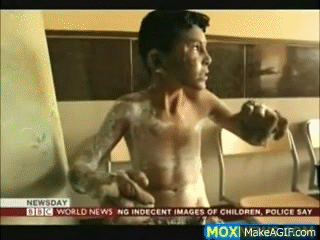


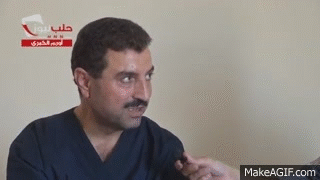
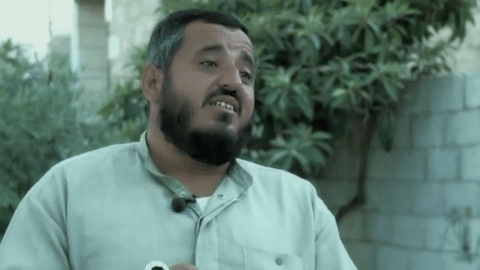







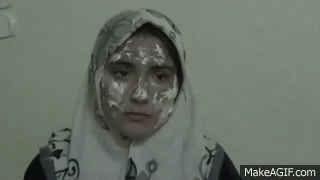





Pingback: Fabricated ? BBC News on Syria – It looks very much like it.Alternative News Network | Alternative News Network
Pingback: How far will they go to propagandise for war? | OffGuardian
Pingback: SYRIA: ‘Hand in Hand’ with Al Qaeda, the Ongoing Exposure of the NGO Complex | Wrong Kind of Green